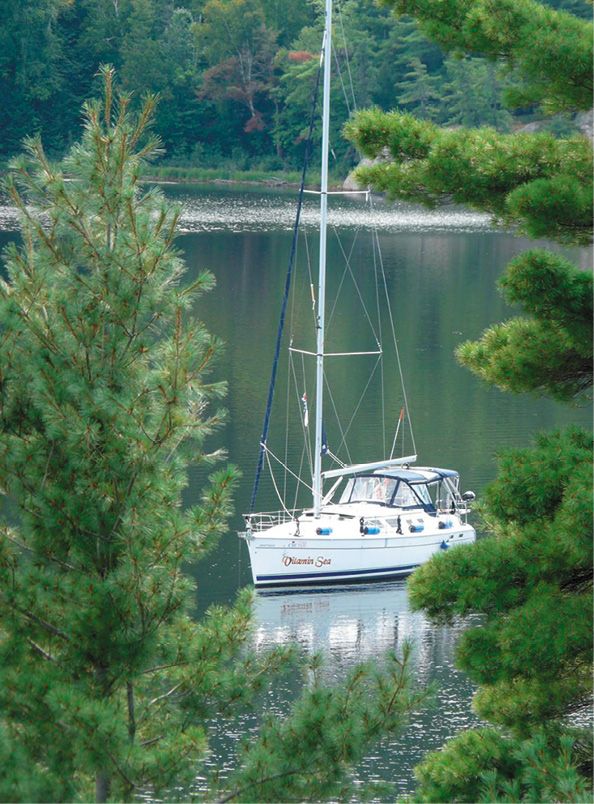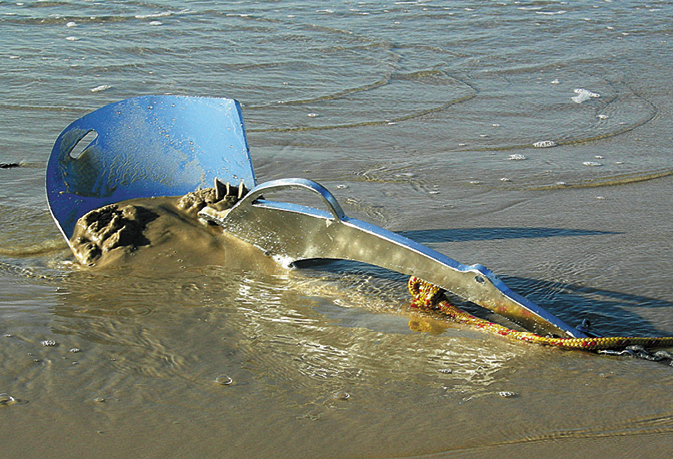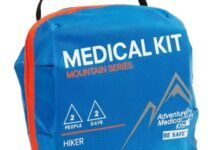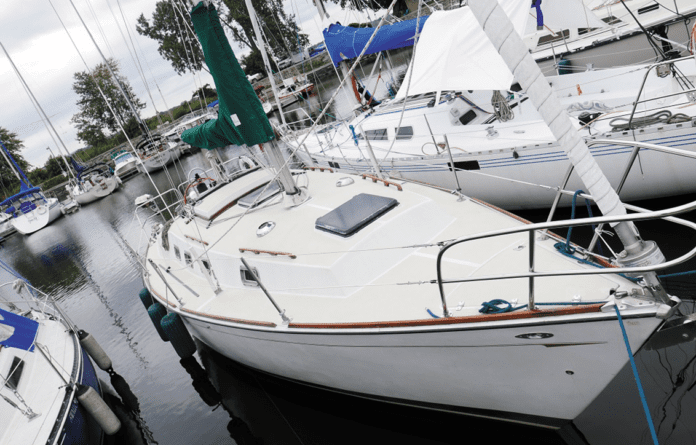MAST-CLIMBING ABOVE THE HOUNDS
Regarding your recent blog post on mast climbing (see “Going Aloft Sans Butterflies,” Inside Practical Sailor), my fractional rigged boat has only one halyard which goes to the top. How, other than using that halyard on its own, would one ever get a second halyard to the top?
Matthew McGarvey
Spindrift, Ticon 30
Ottawa, Ontario
We’ve covered this in another report on how to use a common mountaineering sling for mast-climbing (see “Going Aloft with the Multi-use Prusik,” PS December 2021). As we describe in that report: “A more common application [for a prusik sling] is to protect the climbing above the hounds on a 3/4 or 7/8 rig. Just climb the mast in the normal manner. When you reach the top of your safety line, wrap a prusik sling twice around the mast above the hounds, clip that to your harness and then unclip from the former safety line. Alternatively, you can just slack off the original safety line, leaving it in place as a backup and for the descent. Continue climbing, sliding the prusik up with each step. To descend, reverse the process.” We always take a prusik sling with us when we go aloft, since we never know when we might need it.
KUDOS TO MAGICEZY
I know that from time to time you underline great service. Well, Kelly from MagicEzy sure made my life easier. After reading the review on gelcoat repair in Practical Sailor I decided to purchase two tubes from them (see “Magic Fix for Hairline Cracks in Gelcoat,” PS January 2018). However, I did not get to use it before this summer. Unfortunately, I found that one of the tubes was partially hard as a rock before I opened it. So, I used the second tube to fill small gelcoat cracks to rave reviews from the admiral (my wife) and contacted MagicEzy. Kelly was very professional in his approach and sent me a new tube that arrived like magic within days. (They are in Australia, and I am in Canada, so I was expecting at least a week or more turnaround time.) I would like to underline their quick and professional service.
Guy Lazure
Vitamin Sea, Hunter 41 DS
Wiarton, Ontario

RUST-OLEUM FOR PROP PROTECTION
Regarding your recent report on prop paints (see “Propeller Paints that Last,” PS December 2022), I have tested a wide range of prop paints over the last few years including Prop Speed, Velox, Pettit Zinc Coat, Pettit Running Gear Guardian, and Prop Glide. None worked for more than a season due to some of the coating coming off, resulting in the need to strip and redo it every year. You can’t patch bare spots with those coatings. Last year, I stripped everything and used Rust-oleum Cold Galvanizing Compound spray (at the suggestion of someone on one of the boating forums). It was easy to apply and worked great for the entire season. After power washing last fall, I just cleaned up a few spots and touched up the prop and shaft with the spray and my diver reports it is just as good as last year. Cheaper, easier and does the job!
David Knecht
C&C 34+
New London, CT
PETTIT PROP COAT IN NEW ENGLAND
Thanks for doing the prop paint testing, it is great to know ahead of time how well these expensive products work. I used Pettit Prop Coat this season and have had reasonable luck with it in the past. It seems to be very popular here in New England, perhaps because of our short seasons and cooler waters it is a decent option.
I noted that several paints call for professional application. I had the misfortune of having my boat at one of New England’s “premiere” yards this last winter and witness some of their work first hand. I was underwhelmed by the quality of their workmanship of nearly every job I saw. The takeaway is that even when you pay professionals to do a job, inspect their work. You may be surprised to see that you do better work.
David Dines
Teal Heron, 1994 Catalina 320
Beverly Harbor, MA
GPS MESSENGERS
I’ve used a Spot GPS tracker in the past as part of long-distance Gulf races. I recently purchased the “new and improved” model “Spot X 2-way satellite messenger” expecting similar service during my retirement cruising; I’m now in Jamaica. The Spot X has been a terrible device. On my crossing from Pensacola to St. Petersburg it generated just two points, at the start and at the end, both initiated by me with a “check-in”. Customer service was also disappointing.
Steven Fetherston
via PS Online
Thanks for sharing. We’ll be including the Spot X and similar products in an updated report on satellite messengers and personal locator beacons (PLBs) to be published in the year ahead.
For northern latitude sailors, winter allows time to check gear and knock off items on our ever-expanding “to do” list. It’s also a good time to explore used gear chandleries and online vendors for some bargain buys. Don’t know where to start? Our online archives have got you covered from bow to stern.
ANCHORING
When the late legendary anchor designer Alain Poiraud wanted to test his new anchor (right), he called PS because of our long reputation for objective anchor tests. You can learn how Poiraud’s novel designs like the Spade fared against competitors in sand, mud, and rocky bottoms, and how to best cope with challenging anchoring situations in our recently updated five-volume ebook “Anchors,” now available in our online bookstore (www.practical-sailor.com/product/anchors-complete-series).

WINTER SAILING
If you don’t mind a little frost bite, Technical Editor Drew Frye, aka The Ambassador of Chill, will be your best friend this winter. Over the years, Frye has outlined specific measures for extending your sailing through the winter. Some fan favorites include “Winter Sailing Tips for Diehards” (PS November 2016), “Trouble-free Winter Sailing,” (PS November 2017), and a report on devices that can keep marina slips ice-free through to spring “Keeping Ice at Bay,” (PS November 2016).
GEAR CHECK
The offseason is a good time to go over your essential deck gear, when the weather allows. Winches and windlasses need special attention, usually with a fresh dose of lubricating, protective grease. We’ve got dozens of reports on routine inspections and maintenance ranging from winches and windlasses to chainplates and keelbolts. Of particular interest is our ground-breaking research into inexpensive gear lubricants and greases. See the Inside Practical Sailor blog post “Simple Tips on Servicing Your Sailboat Winches,” for links to a half-dozen articles on practices and products for maintaining your winches.

SAIL SHOPPING
Got tired sails? Our recent sail reports focus on reconditioning old sails, including recutting a mainsail (see “Getting the Most Out of Older Sail, PS January 2022), painting a UV cover (see “The Case of the Painted Jib,” PS January 2021), repairing a torn genoa (see “4 Years Later Sail Repairs Hold Well,” PS March 2020) and eliminating mildew (see “Quick and Safe Sail Cleaning,” PS February 2018). For new sail buyers, nothing beats our three-part ebook series, “A Look at Sails” (www.practical-sailor.com/product/practical-sailors-a-look-at-sails-complete-series)









































